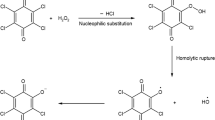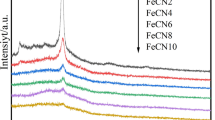Abstract
Cr(VI) and phenol are toxic contaminants that need to be treated, and different methods have been researched to simultaneously remove these two contaminants from industrial wastewater. In this study, Cr(VI) was used as a novel Fenton-like catalyst in phenol degradation by H2O2. In the pH range of 3.0‒11.0, the degradation efficiency of phenol decreased with elevated pH. At pH = 3.0, 100 mg/L phenol was effectively degraded by 2 mmol/L Cr(VI) and 20 mmol/L H2O2. At pH = 7.0 and the same conditions as those of pH = 3.0, 79% of 100 mg/L phenol was removed within 6 h, which was an improvement in pH limitation compared with the Fe(II)-mediated Fenton reaction. Quenching experiments indicated that ·OH generated from the catalysis of H2O2 by Cr(V) instead of Cr(VI) was the primary oxidant that degraded phenol. When pyrophosphate was added in the Cr(VI)/H2O2 system, complexes with the Cr(V) intermediate rapidly formed and inhibited H2O2 decomposition, implying that the decomposition of H2O2 to ·OH was catalyzed by Cr(V) instead of Cr(VI). The presence of anions such as chloride and sulfate had insignificant effect on the degradation of phenol. TOC and UV analyses suggest that phenol could not be completely oxidized to CO2 and H2O, and the intermediates identified by high performance liquid chromatography further indicates that maleic acid and benzoquinone were intermediates which may be further degraded into short chain acids, primarily maleic, formic, acetic, and oxalic acids, and eventually into CO2 and H2O. Considering that more than 50% Cr(VI) can also be removed during this process, the Cr(VI)/H2O2 system is more appropriate for the simultaneous removal of Cr(VI) and phenol contaminants from industrial wastewater.










Similar content being viewed by others
References
Busca G, Berardinelli S, Resini C et al (2008) Technologies for the removal of phenol from fluid streams: a short review of recent developments. J Hazard Mater 160(2–3):265–288
Ahmed S, Rasul MG, Martens WN et al (2010) Heterogeneous photocatalytic degradation of phenols in wastewater: a review on current status and developments. Desalination 261(1–2):3–18
Kang N, Lee DS, Yoon J (2002) Kinetic modeling of Fenton oxidation of phenol and monochlorophenols. Chemosphere 47(9):915–924
Andreozzi R, Caprio V, Insola A et al (1999) Advanced oxidation processes (AOP) for water purification and recovery. Catal Today 53(1):51–59
Pera-Titus M, García-Molina V, Baños MA et al (2004) Degradation of chlorophenols by means of advanced oxidation processes: a general review. Appl Catal B 47(4):219–256
Garrido-Ramírez EG, Theng BKG, Mora ML (2010) Clays and oxide minerals as catalysts and nanocatalysts in Fenton-like reactions—a review. Appl Clay Sci 47(3–4):182–192
Heckert EG, Seal S, Self WT (2008) Fenton-like reaction catalyzed by the rare earth inner transition metal cerium. Environ Sci Technol 42(13):5014–5019
Salem IA, El-Maazawi MS (2000) Kinetics and mechanism of color removal of methylene blue with hydrogen peroxide catalyzed by some supported alumina surfaces. Chemosphere 41(8):1173–1180
Chaliha S, Bhattacharyya KG (2008) Wet oxidative method for removal of 2,4,6-trichlorophenol in water using Fe(III), Co(II), Ni(II) supported MCM41 catalysts. J Hazard Mater 150(3):728–736
Duarte F, Maldonado-Hódar FJ, Pérez-Cadenas AF et al (2009) Fenton-like degradation of azo-dye Orange II catalyzed by transition metals on carbon aerogels. Appl Catal B Environ 85(3–4):139–147
Bokare AD, Choi W (2010) Chromate-induced activation of hydrogen peroxide for oxidative degradation of aqueous organic pollutants. Environ Sci Technol 44(19):7232–7237
Liu LD, Wang WM, Liu L et al (2016) Catalytic activities of dissolved and Sch-immobilized Mo in H2O2 decomposition: implications for phenol oxidation under acidic conditions. Appl Catal B 185:371–377
Vander Griend DA, Golden JS, Arrington CA Jr (2002) Kinetics and mechanism of chromate reduction with hydrogen peroxide in base. Inorg Chem 41(26):7042–7048
Perez-Benito JF, Arias C (1997) A kinetic study of the chromium (VI) hydrogen peroxide reaction: role of the diperoxochromate (VI) intermediates. J Phys Chem A 101(26):4726–4733
Song H, Liu Y, Xu W et al (2009) Simultaneous Cr(VI) reduction and phenol degradation in pure cultures of Pseudomonas aeruginosa CCTCC AB91095. Biores Technol 100(21):5079–5084
Bagchi D, Stohs SJ, Downs BW et al (2002) Cytotoxicity and oxidative mechanisms of different forms of chromium. Toxicology 180(1):5–22
Wang Z, Bush RT, Sullivan LA et al (2013) Simultaneous redox conversion of chromium(VI) and arsenic(III) under acidic conditions. Environ Sci Technol 47(12):6486–6492
Li Y, Liu LD, Liu L et al (2016) Efficient oxidation of phenol by persulfate using manganite as a catalyst. J Mol Catal A Chem 411:264–271
Han X, Wong YS, Wong MH et al (2007) Biosorption and bioreduction of Cr(VI) by a microalgal isolate, Chlorella miniata. J Hazard Mater 146(1–2):65–72
Wang WM, Song J, Han X (2013) Schwertmannite as a new Fenton-like catalyst in the oxidation of phenol by H2O2. J Hazard Mater 262:412–419
Kotaś J, Stasicka Z (2000) Chromium occurrence in the environment and methods of its speciation. Environ Pollut 107(3):263–283
Park D, Yun YS, Park JM (2004) Reduction of hexavalent chromium with the brown seaweed Ecklonia biomass. Environ Sci Technol 38(18):4860–4864
Pettine M, Campanella L, Millero FJ (2002) Reduction of hexavalent chromium by H2O2 in acidic solutions. Environ Sci Technol 36(5):901–907
Kuznetsova NI, Kuznetsova LI, Likholobov VA (1996) Catalytic properties of Cr-containing heteropolytungstates in H2O2 participated reactions: H2O2 decomposition and oxidation of unsaturated hydrocarbons with H2O2. J Mol Catal A Chem 108(3):135–143
Zhang L, Lay PA (1998) EPR spectroscopic studies on the formation of chromium(V) peroxo complexes in the reaction of chromium(VI) with hydrogen peroxide. Inorg Chem 37:1729–1733
Sugden KD, Wetterhahn KE (1996) EPR evidence for chromium(V) binding to phosphate and pyrophosphate: implications for chromium(V) DNA interactions. Inorg Chem 35(13):3727–3728
Maciel R, Sant’Anna GL Jr, Dezotti M (2004) Phenol removal from high salinity effluents using Fenton’s reagent and photo-Fenton reactions. Chemosphere 57(7):711–719
De Laat J, Le Truong G, Legube B (2004) A comparative study of the effects of chloride, sulfate and nitrate ions on the rates of decomposition of H2O2 and organic compounds by Fe(II)/H2O2 and Fe(III)/H2O2. Chemosphere 55(5):715–723
Gallard H, De Laat J (2000) Kinetic modelling of Fe(III)/H2O2 oxidation reactions in dilute aqueous solution using atrazine as a model organic compound. Water Res 34(12):3107–3116
Santos A, Yustos P, Quintanilla A (2002) Route of the catalytic oxidation of phenol in aqueous phase. Appl Catal B Environ 39(2):97–113
Liu L, Liu H, Zhao YP et al (2008) Directed synthesis of hierarchical nanostructured TiO2 catalysts and their morphology-dependent photocatalysis for phenol degradation. Environ Sci Technol 42(7):2342–2348
Zazo JA, Casas JA, Mohedano AF (2005) Chemical pathway and kinetics of phenol oxidation by Fenton’s reagent. Environ Sci Technol 39(23):9295–9302
Acknowledgements
This study was supported by the National Natural Science Foundation of China (No. 41373114 and 51508384), the Natural Science Foundation of Tianjin (No. 15JCZDJC40200), and the Foundation of Key Lab of Indoor Air Environment Quality Control (Tianjin University).
Author information
Authors and Affiliations
Corresponding author
Electronic supplementary material
Below is the link to the electronic supplementary material.
Rights and permissions
About this article
Cite this article
Zeng, Q., Jia, S., Gong, Y. et al. Catalytic Activity of Cr(VI) in the Degradation of Phenol by H2O2 Under Acidic Conditions. Trans. Tianjin Univ. 25, 567–575 (2019). https://doi.org/10.1007/s12209-018-0182-2
Received:
Revised:
Accepted:
Published:
Issue Date:
DOI: https://doi.org/10.1007/s12209-018-0182-2




